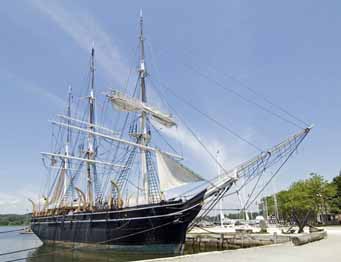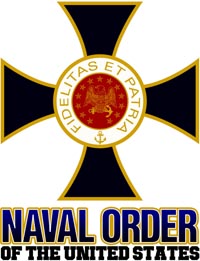News & Tall Tales. 1800s.

Whaleships: Charles W. Morgan
° Passenger Ship Arrivals
As one of over 2,700 whaling ships in the American fleet, the Charles W. Morgan spent 80 years, or 37 separate voyages, hunting whales. She was known as a lucky ship because she always returned a profit regardless of rough seas, storms, or cannibals. Whaling expeditions often lasted three years or longer before returning home. She was in San Francisco on multiple occasions and was in the news throughout her career.
 Charles W. Morgan was built and launched in 1841 in the yard of Jethro and Zachariah Hillman in New Bedford, Massachusetts, the whaling capital of the world. The ship is named for her original owner, a Quaker whaling merchant who ordered its construction from the shipbuilders Jethro and Zachariah Hillman of New Bedford, Massachusetts. The ship's maiden voyage began on September 6, 1841, with a journey around Cape Horn and across the Pacific Ocean. Following Charles W. Morgan's initial three-year, four-month voyage, she came home with 1,600 barrels of sperm oil, 800 barrels of whale oil and 10,000 lb (4,500 kg) baleen (whalebone) which was worth around US$56,000.
Charles W. Morgan was built and launched in 1841 in the yard of Jethro and Zachariah Hillman in New Bedford, Massachusetts, the whaling capital of the world. The ship is named for her original owner, a Quaker whaling merchant who ordered its construction from the shipbuilders Jethro and Zachariah Hillman of New Bedford, Massachusetts. The ship's maiden voyage began on September 6, 1841, with a journey around Cape Horn and across the Pacific Ocean. Following Charles W. Morgan's initial three-year, four-month voyage, she came home with 1,600 barrels of sperm oil, 800 barrels of whale oil and 10,000 lb (4,500 kg) baleen (whalebone) which was worth around US$56,000.
The Morgan s overall length is 113 feet, with a 27-foot 6-inch beam and depth of 17 feet 6 inches. Her main truck is 110 feet above the deck; fully-rigged, and she is capable of carrying approximately 13,000 square feet of sail. The huge try-pots used for converting blubber into whale oil are forward; below are the cramped quarters in which her officers and men lived for years at a time.
Charles W. Morgan sailed with more than 1,000 whalemen of all races and nationalities during her history. As did many of the whaling ships, crews included Americans, sailors from Cape Verde, New Zealand, the Seychelles, Guadeloupe, and Norfolk Island. The ship's crew averaged around 33 men per voyage. As with other whaleships in the 19th century, Charles W. Morgan was often home to the captain's family. Charles W. Morgan was owned and managed by the J. & W. R. Wing Company of New Bedford.
Though whales were never hunted in San Francisco Bay itself, the whaling industry had a long presence along the Pacific Coast. Beginning in the 1830s, whaling ships of British and New England based fleets wintered in San Francisco Bay.
A hundred ships or more might be anchored along the San Francisco waterfront, where they stocked up on provisions for their long Pacific and Arctic voyages. In addition to this well-financed pelagic whaling, a small-scale commerce in coastal whales (gray, humpback, orca), hunted from rowboats that went out for the day, developed in several coastal communities, including Carmel, Monterey, Moss Landing, Davenport, Half Moon Bay, and Bolinas.
June 17, 1885, Daily Alta California, San Francisco
Profits of Whale Ships.
The profits of some whaling vessels are still very large, despite the fact that many more are engaged in it now than formerly. Some Scotch vessels have paid from 45 to 65 per cent, for the past twenty years. The black whale fishery shows signs of exhaustion as now prosecuted, but the waters between Spitsbergen and Franz Josef Land are declared to be the great black whale fishing grounds of the future, because inexhaustible. The bottle-nose whale fishery is still very successful. Many vessels are fishing for them in Davis Straits and on the coasts of Greenland and Labrador. Only Scotchmen and Norwegians are following this bottle-nose fishery, because Americans have not yet found it out.
With the advent of mechanized whaling in the early 1900s, whalers were able to exploit faster species (blue, fin, sei), and the industry revived for a few decades.
The oil was used most often in oil lamps and to make soap. Baleen or whalebone had many uses including corset stays, men s collars, buggy whips, and cutlery handles. Scrimshaw, the carvings done by sailors in the off watches, were done on whale teeth and the larger bones. The engravings were usually of ships, but could be of any subject.
October 30, 1900, San Francisco Call, San Francisco, California
FIRST OF THE WHALERS IN.
Old Bark Charles W. Morgan Arrives From the Okhotsk Sea.

The whaling bark Charles W. Morgan, arrived from the Okhotsk Sea yesterday with 1400 barrels of sperm oil, 270 barrels whale oil and 3000 pounds of whalebone. She had a very uneventful trip and only spoke one other vessel of the fleet. The latter vessel was theCalifornia and on September 9 she had 200 barrels of sperm and 270 barrels of whale oil and 3000 pounds of whalebone. The work of getting the Morgan ready for another cruise will begin at once. Shipping Intelligence: Captain Scullum, 30 days from Ahkotsk Sea.
November 1, 1891, San Francisco Call, San Francisco, California, U.S.A.
Another Whaler in Port
The whaling bark Charles W. Morgan came in last night from the Okhotsk Sea with 500 barrels of oil and 5000 pounds of bone for J. and W. R. Wing.
June 16, 1901, Los Angeles Herald, Los Angeles, California
WHALER ON FIRE
The Charles W. Morgan Is Lost
VICTORIA. B. C., June 15. The steamer Tacoma, which arrived today from the Orient, reports that on June 2 she sighted a ship on fire which proved to be the San Francisco whaler, Charles W. Morgan. Tacoma bore down, but the fire was under control and the whaler not wanting further assistance, the Tacoma came on. The take of the whaler was reported lost.
August 24, 1901, Los Angeles Herald, Los Angeles, California
Catch of Whale Ships
SAN FRANCISCO, Aug. 23. Up to July 4 the catch of the whaling vessels out of this port is reported to have been as follows: Charles W. Morgan, 1200 barrels of sperm oil and 3400 pounds of bone; California, 900 barrels of sperm oil; Gayhead, 500 barrels of sperm oil; Alice Knowles, 300 barrels of sperm oil and two small right whales; John and VVinthrop, 180 barrels of sperm oil.
November 20, 1902, San Francisco Call, San Francisco, California
Whalers Start Again
The whaling barks Charles W. Morgan and California have cleared for another whaling cruise, and within a few days all the blubber hunters that are not going to lay up for the winter will be heading for the whaling grounds. A number of the fishermen emploved during the summer at the Alaska canneries have shipped on the California and Morgan.
October 27, 1903, San Francisco Call, San Francisco, California
First of the Whalers.
The whaling bark Charles W. Morgan passed Point Reyes at 2:30 yesterday afternoon and will be in port probably some time to-day. She has been In the Okhotsk Sea and is the first of the fleet to put in an appearance. The Morgan is owned by J. and W. R Wing of New Bedford, whose representative arrived here a few days ago.
October 29, 1903, San Francisco Call, San Francisco, California
First Whaler Docks

The whaling bark Charles W. Morgan, which arrived on Tuesday, docked yesterday at the Howard street bulkhead and commenced discharging her cargo of sperm oil.
November 1, 1904, Los Angeles Herald, Los Angeles, California
BRINGS GOOD CATCH
Whaling Bark Charles W. Morgan Arrives at San Francisco
By Associated Press. SAN FRANCISCO, Oct. 31
The whaling bark Charles W. Morgan has arrived here with a good catch, amounting to 1450 barrels of sperm oil, 150 barrels of whale oil, the product of forty-six sperm and two right whales, and whalebone weighing 2100 pounds. After leaving Hakodate in July, where the Morgan received the first information of the Russo-Japanese war through a warning in regard to navigating the mined entrance of the harbor, she spoke the whaling bark Andrew Hicks on August 17. TheHicks reported then a catch of 800 barrels of sperm oil. The bark was refused a landing at the Caroline islands.
November 19, 1903, San Francisco Call, San Francisco, California
First Whaler Gets Away.
The whaling bark Charles W. Morgan started yesterday on her regular cruise. She will hunt whales during the winter months in the South Seas, will later follow the leviathans to Japanese waters and will finish up, late next summer, in the Okhotsk Sea.
She is the first of the fleet to get away.

The Naval Order of the United States has a history dating from 1890. Membership includes a wide range of individuals, many with highly distinguished career paths.
The San Francisco Commandery meets the first Monday of each month at the San Francisco Italian Athletic Club in San Francisco, California and holds two formal dinners each year.


 Copyright ~ 1998-2018.
Copyright ~ 1998-2018. 